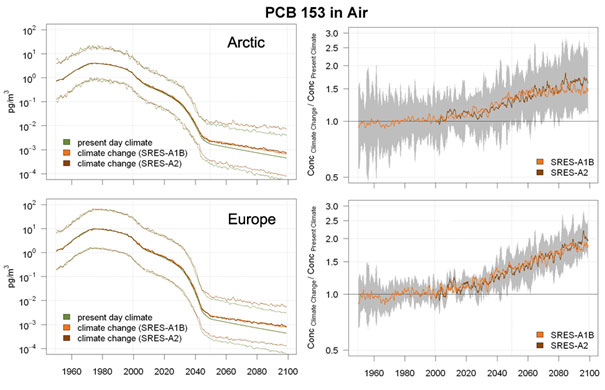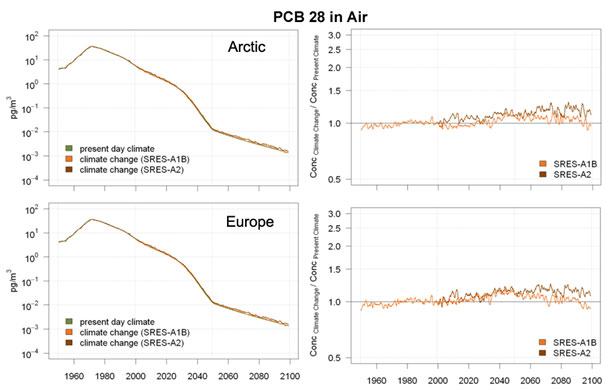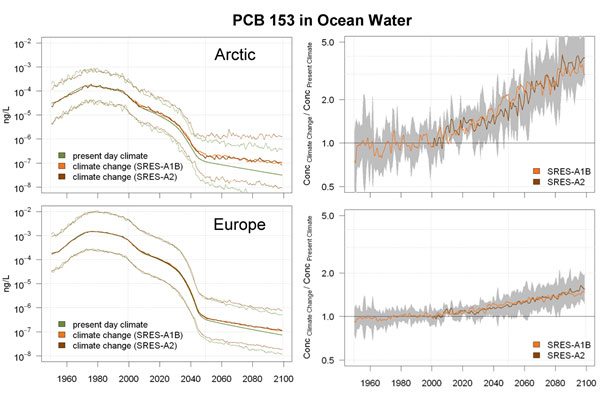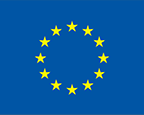Emissions, pathways and modelled impacts of climate change: Polychlorinated (PCBs)
The fate and transport of PCBs in the global environment were studied using three models: MPI-MCTM, BETR Research, and DEHM. Model results indicate that the effect of global climate change on atmospheric concentrations of PCB-153 in the Arctic is a relative increase of about a factor of 1.5. In the atmosphere over Europe, the model forecasts a more pronounced effect of about a factor of 2. The modelled increases are mostly due to the temperature effect on the volatilization from primary and secondary emission sources. On the other hand, PCB-28 is less sensitive to climate change according to the model, with an effect which is thought to lie within the parameter uncertainties. See figures below.
The impact of climate change on PCB-153 in Arctic ocean water are modelled to be bigger than in the atmosphere, with relative increases by a factor of 3–4. Over Europe, the increase is a factor of about 1.5. The modelled increases are a result of the combined effect of higher atmospheric concentrations (see above) and increased deposition into the Arctic Ocean due to the retreat of Arctic sea-ice. PCB-28 increases by a factor of about 2.5–3 in the Arctic Ocean. In European Ocean water, our model indicates a decreasing trend, however, this is thought to lie within the parameter uncertainties.
The bioavailability of PCB-153 is expected to increase in a changed climate. More PCB-153 will then be associated with particulate organic carbon, and especially with the dissolved organic carbon, which is the main food source for many organisms at low trophic levels.
Although the relative increases (by factors of up to five times) were found to be significant, the absolute concentrations by the end of the 21st century are several orders of magnitude below present levels in all scenarios modelled. Thus, in terms of exposure, the climate change effect can be considered of minor importance. The most important reasons for declining concentrations are biodegradation and the world-wide ban of PCB production and usage. Hence, no PCB should be produced and released to the environment anymore.
MPI-MCTM model
The concentrations of PCB tend to increase in air, sea ice and in soils due to the climate change and therefore override the decreasing primary emissions. More PCB will be stored in most parts of the sea ice covered Arctic Ocean and input by precipitation will increase, but PCB can evaporate from ice-free surface seawater.
The total environmental residence time (persistence) of PCB-153 will be reduced by 40 percent in the 2090s versus 1990s, mostly because of enhanced biodegradation in soil and water. The residence time of PCB-28 will increase in the Arctic because of a changing distribution, towards soil and land ice.
Three modelling groups within ArcRisk have analysed the impacts of climate change on PCBs in the global environment. The models are in good qualitative agreement with regard to the expected impacts of climate change on PCB concentrations in the Arctic.
BETR Research model
Results from the BETR Research model, based on SRES A1B and the SRES A2 scenarios, indicate that the effect of global climate change on atmospheric concentrations of PCB-153 in the Arctic is a relative increase of about a factor of 1.5 and a factor of 3-4 in Arctic Ocean. In the atmosphere over Europe, the model forecasts a more pronounced effect of about a factor of two. On the other hand, PCB-28 is less sensitive to climate change according to the model, with an effect in air that likely lies within the parameter uncertainties. See figures for air and ocean below.
Although the modelled concentrations of PCBs were found in some cases to be significantly higher under the climate change scenarios (by factors of up to 5 times), the absolute concentrations by the end of the 21st century are forecasted to be several orders of magnitude below present levels in all scenarios. Thus, in terms of exposure, the climate change effect can be considered of minor importance.


MPI-MCTM


PCB cycling in a changing climate (A1B scenario of the IPCC AR4) was simulated using a multi-compartment chemistry-transport model, MPI-MCTM¸ Guglielmo et al., 2009. PCB levels in air, sea ice, and soils tend to increase, thus compensating for decreasing primary emissions. PCB is expected to volatilize from ice-free surface seawater. More will be stored in most parts of the sea-ice covered Arctic Ocean, except in the Laptev Sea, see figure below, and input by precipitation will increase. The total environmental residence time (persistence) of PCB-153 however, will be reduced by 40% in the 2090s versus the 1990s, mostly resulting from an enhanced biodegradation in soil and water. The total environmental residence time of PCB-28 will increase in the Arctic as a consequence of a shifting compartmental distribution towards soil and land ice.

Primary production in Arctic seas is expected to increase due to reduced sea-ice cover and enhanced upwelling (ACIA, 2005), and the processes governing bioaccumulation of PCBs and other persistent organic pollutants are temperature dependent. Thus, changes in magnitude and relevance for bioavailability can be assumed for several climate change scenarios. However, so far only a few scientific studies have been published dealing with this issue. One potential effect is that increased temperature may reduce the overall bioaccumulation of organic contaminants in the Arctic marine food web due to higher uptake and elimination rates (Borgå et al., 2010).
In the future climate (under the A1B scenario of the IPCC AR4), more suspended material is predicted for Arctic seawater (> 66° N), for example, an increase of +72 percent of phytoplankton for the 2090s as compared to the 1990s in response to enhanced primary production in a simulation using MPI MCTM, which includes an ocean biogeochemistry sub-model (Guglielmo et al., 2009; Lammel and Stemmler, 2012). Correspondingly, more PCB is expected to be associated with the particulate phase, i.e., 4.6 percent, 12.6 percent and 19.8 percent more of PCB-101, PCB-153 and PCB-180, respectively, in the 2090s as compared to the 1990s. Therefore, the bioavailability of PCBs at the bottom of the marine food chain is expected to increase.
Modelled concentrations of PCBs during 1990-1999 and 2090-2099, with identical initial conditions and PCB emissions, using climate data based on the SRES A1B scenario for the period 2001 to 2100, were compared. The concentrations in Arctic Ocean were predicted to decrease for all PCBs.
For low- and mid-chlorinated PCBs, such as PCB-28 and PCB-101, modelled atmospheric concentrations for 2090-2099 in Arctic air were similar to 1990-1999, while concentrations in Arctic Ocean water and soils were 20-40% lower during 2090-99. Higher-chlorinated PCBs (e.g. PCB-153), showed about 5 percent higher modelled concentrations in Arctic air during 2090-99 compared to 1990-99. The concentrations in Arctic Ocean water were about 40 percent lower, and concentrations in Arctic soils were similar. The highest-chlorinated PCB congeners that were considered (PCB-180 and PCB-194), modelled concentrations in Arctic air were 15 percent higher during 2090-2099, the Arctic Ocean water concentrations were 10 percent lower, and concentrations in Arctic soils were slightly higher compared to 1990-99. Except for the higher concentrations in soil of the highest-chlorinated congeners, the pattern for the environmental concentrations in the Arctic follows the pattern in the rest of the model domain.





















